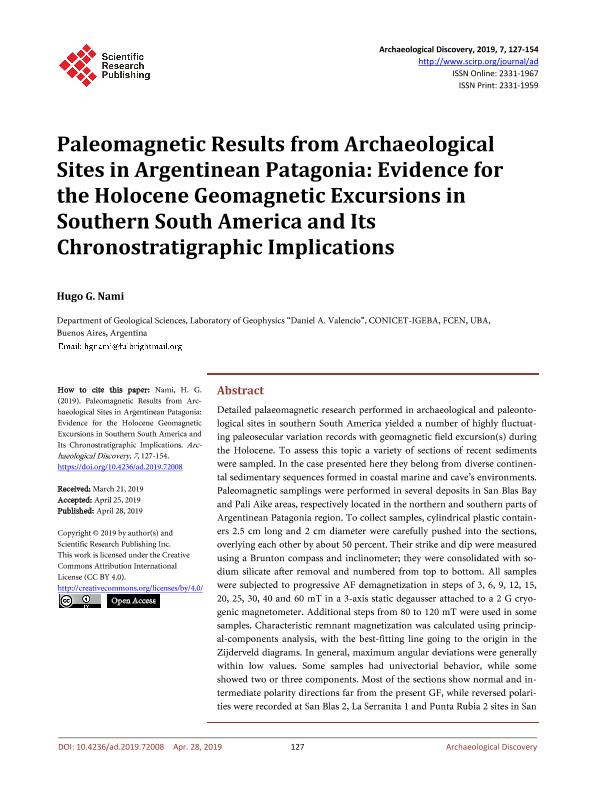Mostrar el registro sencillo del ítem
dc.contributor.author
Nami, Hugo Gabriel

dc.date.available
2020-12-11T19:28:31Z
dc.date.issued
2019-04
dc.identifier.citation
Nami, Hugo Gabriel; Paleomagnetic Results from Archaeological Sites in Argentinean Patagonia: Evidence for the Holocene Geomagnetic Excursions in Southern South America and Its Chronostratigraphic Implications; Scientific Research; Archaeological Discovery; 7; 2; 4-2019; 127-154
dc.identifier.issn
2331-1959
dc.identifier.uri
http://hdl.handle.net/11336/120276
dc.description.abstract
Detailed palaeomagnetic research performed in archaeological and paleontological sites in southern South America yielded a number of highly fluctuating paleosecular variation records with geomagnetic field excursion(s) during the Holocene. To assess this topic a variety of sections of recent sediments were sampled. In the case presented here they belong from diverse continental sedimentary sequences formed in coastal marine and cave?s environments. Paleomagnetic samplings were performed in several deposits in San Blas Bay and Pali Aike areas, respectively located in the northern and southern parts of Argentinean Patagonia region. To collect samples, cylindrical plastic containers 2.5 cm long and 2 cm diameter were carefully pushed into the sections, overlying each other by about 50 percent. Their strike and dip were measured using a Brunton compass and inclinometer; they were consolidated with sodium silicate after removal and numbered from top to bottom. All samples were subjected to progressive AF demagnetization in steps of 3, 6, 9, 12, 15, 20, 25, 30, 40 and 60 mT in a 3-axis static degausser attached to a 2 G cryogenic magnetometer. Additional steps from 80 to 120 mT were used in some samples. Characteristic remnant magnetization was calculated using principal-components analysis, with the best-fitting line going to the origin in the Zijderveld diagrams. In general, maximum angular deviations were generally within low values. Some samples had univectorial behavior, while some showed two or three components. Most of the sections show normal and intermediate polarity directions far from the present GF, while reversed polarities were recorded at San Blas 2, La Serranita 1 and Punta Rubia 2 sites in San Blas Bay as well Saenz cave in the Pali Aike area. They show similar directions observed in nearby sites from southern Patagonia in Argentina and Chile. In fact, previous results obtained at Mylodon, Cueva del Medio, Don Ariel and Las Buitreras caves yielded remanence directions corresponding to obliquely normal, obliquely reversed and reversed field polarity directions with similar VGPs. This situation strengthens the hypothesis of the existence of the Mylodon excursion in southern Patagonia. On the other hand, the presence of intermediate and reverse VGPs in San Blas records and other sites also supports its regional extent in the southern cone of South America. If the presented paleomagnetic features are true GMF behavior, the remarkably PSV record can serve to correlate regional stratigraphies, and to determine relative and absolute chronologies. Besides, if the anomalous directions represent excursions, they may be also used as dating devices, becoming excellent magnetostratigraphic markers for the time-span covered by the paleomagnetic record of the sites presented in this paper.
dc.format
application/pdf
dc.language.iso
eng
dc.publisher
Scientific Research
dc.rights
info:eu-repo/semantics/openAccess
dc.rights.uri
https://creativecommons.org/licenses/by/2.5/ar/
dc.subject
PALEOMAGNETISM
dc.subject
GEOMAGNETIC EXCURSIONS
dc.subject
ARCHAEOLOGICAL SITES
dc.subject
HOLOCENE
dc.subject.classification
Arqueología

dc.subject.classification
Historia y Arqueología

dc.subject.classification
HUMANIDADES

dc.title
Paleomagnetic Results from Archaeological Sites in Argentinean Patagonia: Evidence for the Holocene Geomagnetic Excursions in Southern South America and Its Chronostratigraphic Implications
dc.type
info:eu-repo/semantics/article
dc.type
info:ar-repo/semantics/artículo
dc.type
info:eu-repo/semantics/publishedVersion
dc.date.updated
2020-11-20T17:48:10Z
dc.journal.volume
7
dc.journal.number
2
dc.journal.pagination
127-154
dc.journal.pais
Estados Unidos

dc.description.fil
Fil: Nami, Hugo Gabriel. Consejo Nacional de Investigaciones Científicas y Técnicas. Oficina de Coordinación Administrativa Ciudad Universitaria. Instituto de Geociencias Básicas, Aplicadas y Ambientales de Buenos Aires. Universidad de Buenos Aires. Facultad de Ciencias Exactas y Naturales. Instituto de Geociencias Básicas, Aplicadas y Ambientales de Buenos Aires; Argentina
dc.journal.title
Archaeological Discovery
dc.relation.alternativeid
info:eu-repo/semantics/altIdentifier/doi/http://dx.doi.org/10.4236/ad.2019.72008
dc.relation.alternativeid
info:eu-repo/semantics/altIdentifier/url/https://www.scirp.org/journal/paperinformation.aspx?paperid=92123
Archivos asociados
